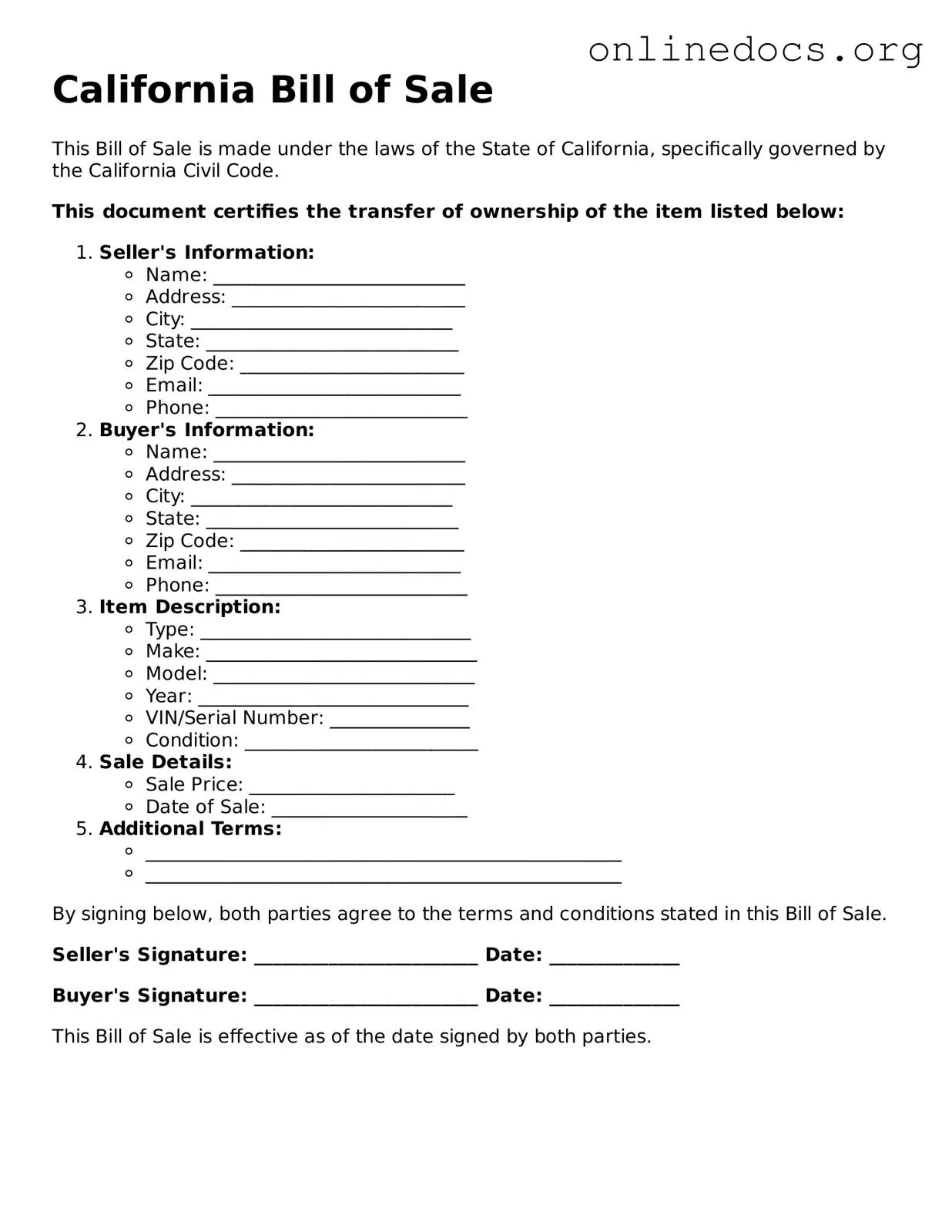The California Bill of Sale form shares similarities with a Vehicle Title Transfer form. Both documents serve as proof of ownership transfer for a vehicle. When a buyer purchases a car, the seller must complete the Vehicle Title Transfer form, which is then submitted to the Department of Motor Vehicles (DMV). This ensures that the vehicle's title is updated to reflect the new owner's information. Like the Bill of Sale, this form provides essential details about the vehicle, including the Vehicle Identification Number (VIN), and confirms that the transaction has taken place legally.
Another document akin to the California Bill of Sale is the Purchase Agreement. This agreement outlines the terms and conditions of a sale between a buyer and a seller. While the Bill of Sale serves as a receipt and proof of transfer, the Purchase Agreement details the specifics of the transaction, such as the purchase price, payment method, and any warranties or conditions attached to the sale. Both documents protect the interests of the parties involved, ensuring clarity and mutual understanding in the transaction.
The Lease Agreement is yet another document that bears resemblance to the Bill of Sale. While a Bill of Sale indicates a transfer of ownership, a Lease Agreement outlines the terms under which one party can use another party's property for a specified period in exchange for payment. Both documents require the parties to agree on specific terms and conditions, and they both serve as legal evidence of the agreement reached. Each document can be crucial in establishing rights and responsibilities between the involved parties.
In the context of vehicle transactions, understanding the significance of the California ATV Bill of Sale is essential for both buyers and sellers. This document not only serves as verification of the sale but also ensures that the ownership transfer is officially recorded. For more resources and templates related to such documents, you can visit All Templates PDF, which provides useful information on preparing your Bill of Sale efficiently.
A Rental Agreement is similar to the Bill of Sale in that it establishes the terms of a transaction involving property. This document is used when renting personal property, such as equipment or furniture. Like the Bill of Sale, a Rental Agreement includes details about the item being rented, the rental period, and the payment terms. Both documents serve to protect the interests of the parties involved, ensuring that expectations are clear and legally enforceable.
The Warranty Deed is comparable to the Bill of Sale, particularly in real estate transactions. A Warranty Deed transfers ownership of property from one party to another and guarantees that the seller has the legal right to sell the property. While the Bill of Sale is often used for personal property, the Warranty Deed serves a similar purpose for real estate, providing proof of ownership and the terms of the transfer. Both documents are essential for establishing legal ownership and protecting the rights of the new owner.
The Quitclaim Deed also shares characteristics with the Bill of Sale. This document is used to transfer interest in real property without guaranteeing that the title is clear. While a Quitclaim Deed does not provide the same level of protection as a Warranty Deed, it serves as a legal instrument to convey ownership. Similar to the Bill of Sale, it requires the signatures of both parties and serves as evidence of the transfer of interest in the property.
A Promissory Note can be likened to the Bill of Sale in that both documents are related to financial transactions. A Promissory Note is a written promise to pay a specific amount of money at a future date. When a buyer purchases an item and agrees to pay in installments, a Bill of Sale may accompany the Promissory Note to document the sale. Both documents outline the terms of the transaction, including payment details, and serve as legal evidence of the agreement between the parties.
Finally, the Affidavit of Ownership is similar to the Bill of Sale as it serves to establish proof of ownership. This document is often used when a person needs to declare ownership of an item without having a traditional sales receipt. An Affidavit of Ownership may be required in situations where a Bill of Sale is not available, such as inherited items or gifts. Both documents aim to clarify ownership and provide a legal basis for the owner's claims regarding the property in question.
